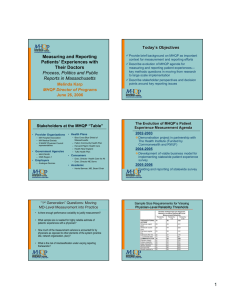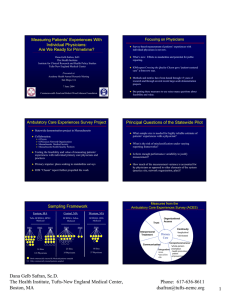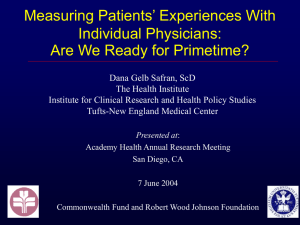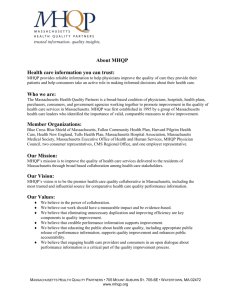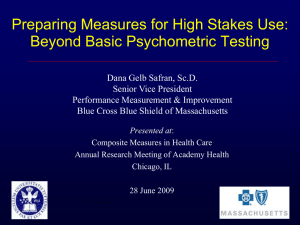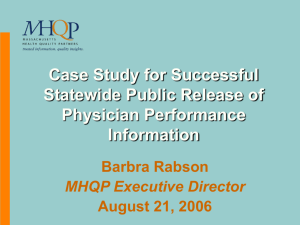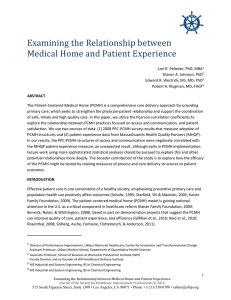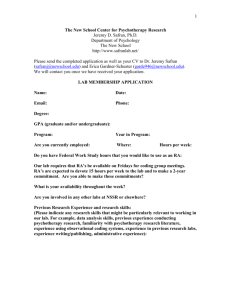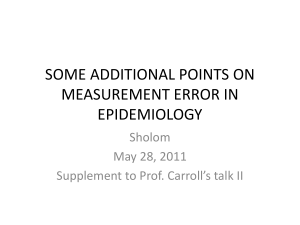Measuring and Reporting Patients’ Experiences with Their Doctors Process, Politics and Public
advertisement
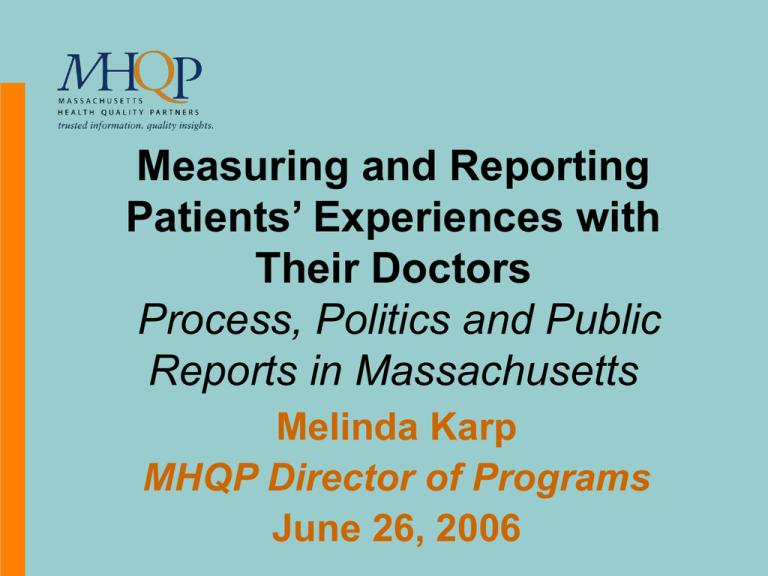
Measuring and Reporting Patients’ Experiences with Their Doctors Process, Politics and Public Reports in Massachusetts Melinda Karp MHQP Director of Programs June 26, 2006 Today’s Objectives Provide brief background on MHQP as important context for measurement and reporting efforts Describe evolution of MHQP agenda for measuring and reporting patient experiences— key methods questions in moving from research to large scale implementation Describe stakeholder perspectives and decision points around key reporting issues Stakeholders at the MHQP “Table” • Provider Organizations – MA Hospital Association – MA Medical Society – 2 MHQP Physician Council representatives • Government Agencies – MA EOHHS – CMS Region 1 • Employers – Analogue Devices • Health Plans – Blue Cross Blue Shield of Massachusetts – Fallon Community Health Plan – Harvard Pilgrim Health Care – Health New England – Tufts Health Plan • Consumers – Exec. Director Health Care for All – Exec. Director NE Serve • Academic – Harris Berman, MD, Board Chair The Evolution of MHQP’s Patient Experience Measurement Agenda 2002-2003 Demonstration project in partnership with The Health Institute (Funded by Commonwealth and RWJF) 2004-2005 Development of viable business model for implementing statewide patient experience survey 2005-2006 Fielding and reporting of statewide survey “1st Generation” Questions: Moving MD-Level Measurement into Practice • Is there enough performance variability to justify measurement? • What sample size is needed for highly reliable estimate of patients’ experiences with a physician? • How much of the measurement variance is accounted for by physicians as opposed to other elements of the system (practice site, network organization, plan)? • What is the risk of misclassification under varying reporting frameworks? Sample Size Requirements for Varying Physician-Level Reliability Thresholds Allocation of Explainable Variance: Doctor-Patient Interactions 100 80 62 60 Doctor 74 77 70 84 Site Network 40 20 Plan 38 25 22 29 16 0 Source: Safran et al. JGIM 2006. Allocation of Explainable Variance: Organizational/Structural Features of Care 100 80 39 36 23 Doctor 60 Site 40 45 56 77 Network Plan 20 16 0 Organizational Access 8 Visit-based Continuity Integration Source: Safran et al. JGIM 2006. Risk of Misclassification Substantially Below Average Average Substantially Above Average MEASURE RELIABILITY (MD) 0 0.9 50 0.01 0 50 0.01 0 0.8 50 0.6 0 50 0.5 0 0.7 50 2.4 0 50 2.4 0 64.6 76.3 50th ptile 90th ptile 52.9 10th ptile 88.0 100 Source: Safran et al. JGIM 2006; 21:13-21. Risk of Misclassification Substantially Below Average Below Average Average Substantially Above Average Above Average MEASURE RELIABILITY (MD) 0 0.9 50 19.7 0.8 50 0.7 3.3 50 2.2 0 50 17.6 3.2 50 0 0 28.5 11.1 50 8.8 0.4 50 27.0 11.2 50 0.4 0 50 33.0 17.3 50 14.7 2.0 50 32.0 17.4 50 2.3 0 0.6 50 36.4 22.5 50 19.9 4.7 50 35.4 22.8 50 5.4 0.1 0.5 50 38.7 27.7 50 25.2 8.7 50 27.3 50 9.7 0.4 52.9 58.5 64.6 70.8 10th ptile 25th ptile 50th ptile 75th ptile 38.3 76.3 100 90th ptile Source: Safran et al. JGIM 2006; 21:13-21. MHQP 2005 Statewide Survey • Physician-level survey format • Site-level sampling to support site-level reporting • Estimated samples required to achieve > 0.70 site-level reliability Site Reliability Chart: Integration Sample sizes needed to achieve site reliability for integration domain. Practice Size (Number of Doctors) 3 4 5 6 7 8 A Site-Level Reliability B C D > 0.7 0.5 – 0.69 0.34 – 0.49 < 0.34 38 48 57 65 72 79 16-37 20-47 24-56 28-64 31-71 33-78 8-15 10-19 12-23 14-27 16-30 17-32 7 9 11 13 15 16 Setting the Stage for Public Reporting: Key Issues for Physicians • What measures get reported • How measures get reported Percent of Sites with A-Level Reliability by Measure and Survey-Type Adult PCP % Pediatric % Communication 98 97 Knowledge of patient 91 86 Health Promotion 46 97 Integration of care 79 61 Access 99 100 Visit-based continuity 100 100 Office Staff 95 99 Clinical Team 37 86 Willingness To Recommend 62 59 MD – Patient Interactions Organizational/Structural Features of Care Framework for Public Reporting Integration of Care 78.7 80.5 ½ 79.6 15th ptile 84.3 86.1 87.9 ½ ½ 85.2 50th ptile 89.7 88. 8 85th ptile Summary and Implications • With sufficient sample sizes, data obtained using C/G CAHPS approach yields data with MD- and site-level reliability >0.70 • For site-level reliability, number of MDs per site influences required sample sizes • Risk of misclassification can be held to <5% with by – Limiting number of performance categories – Creating buffer (“zone of uncertainty”) around performance cutpoints • Trade-offs are likely around data quality standards (e.g., acceptable “risk”) vs. data completeness The Continuing Evolution… 2006-2007 • Engagement around QI activities – Participation in Commonwealth Fund grant to study highest performing practices – Grant proposal to Physician Foundation to develop and pilot integrated clinical-patient experience QI curriculum • Determining achievable benchmarks • Fielding of Specialist Care Survey in 2006/2007 • Repeat Primary Care Survey in 2007 For more information … Melinda Karp, Director of Programs mkarp@mhqp.org 617-972-9056 www.mhqp.org
